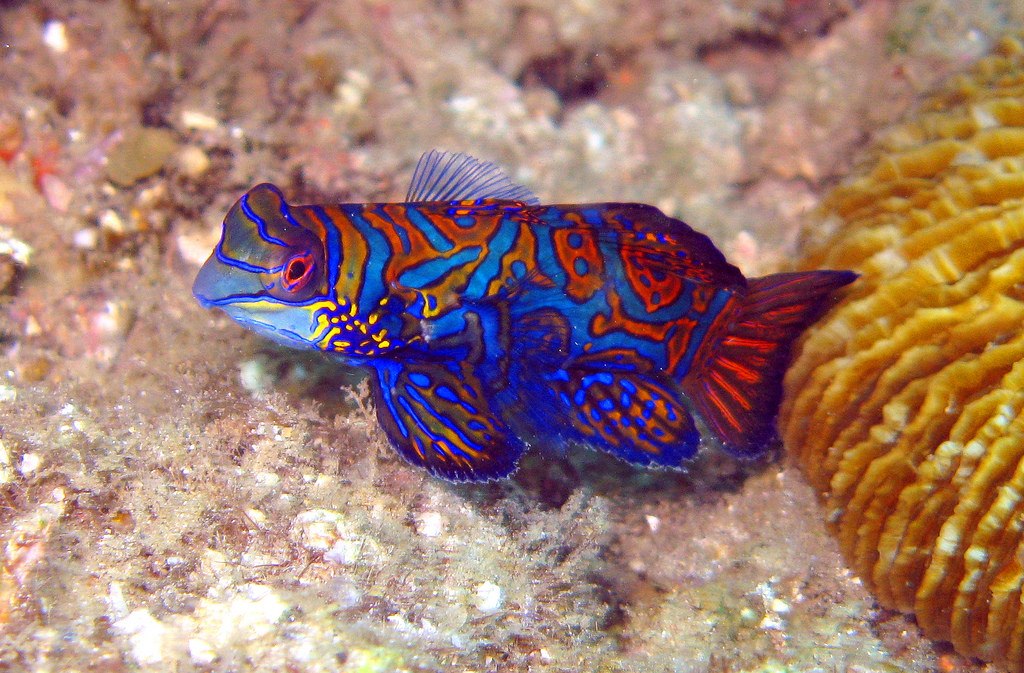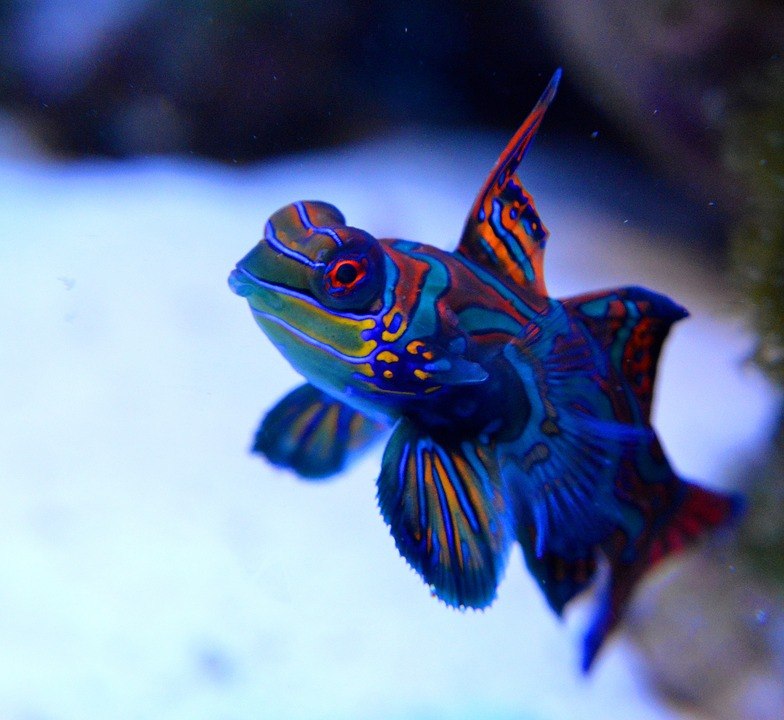With their gorgeous, vibrant colors and stunning stripes, it’s no wonder why the Mandarin Fish (also known as the Mandarin Goby, Psychedelic Goby, or the Mandarin Dragonet) is considered one of the most beautiful fish in the ocean.
Their exotic array of green, yellow, blue, red, and orange coloring makes them popular among aquarium and reef hobbyists alike.
Like any beautiful living thing, the Mandarin Goby requires a lot of care for it to thrive.
Despite being a popular fish, it’s notoriously difficult to raise and keep alive. Without proper care and routine tank maintenance, it will live about as long as a poorly kept goldfish.
However, when given enough attentiveness and dedication, the Mandarin Goby will make a wonderful addition to your aquarium. Below is what you’ll need to know if you’re ready to make the commitment of owning a Mandarin.
Contents
Mandarin Fish: Facts
The Mandarin Goby Fish is a western-Pacific saltwater fish that can be found in the warm waters of the Philippines, Japan, Indonesia, and Australia.
They are slow moving and docile, but eat constantly throughout the day.
Mandarins can grow to four centimeters and can grow larger under the right conditions. The Mandarin has no scales but instead has colorful skin.
They prefer to swim among coral reefs and along the sandy floor.
The most popular Mandarin among reef enthusiasts is the Synchiropus splendidus, which is known for its myriad of colors and unique patterns on its skin. The males are distinguished from the females with their brighter coloring and elongated, pointy dorsal fin.

The Mandarin fish secretes a special fluid that coats and protects them from harmful bacteria, making them less susceptible to disease. This fluid, though, is foul smelling and helps protect it from predators.
As you’ve probably guessed, their bright coloring isn’t just for show. They are in fact poisonous.
This poison is located within its spines and the toxic mucous is released when stressed or threatened. Be careful when handling this fish!
Mandarin Fish For Sale?
Because the Mandarin Goby is an exotic fish, they must be packaged and shipped to their destination, which will most likely be a pet store.
This means that they can go hours to days without proper feeding or nourishment.
When you are selecting your Mandarin fish, you need to use your best judgement. Choose one that looks bright without any frayed fins, make sure that they are swimming without looking lethargic, and look at their bellies to make sure they look full – not emaciated.
Your choice makes all the difference to ensure that your Mandarin is healthy enough to be further handled and introduced to their new home.
The Mandarin isn’t a fish you would commonly see in a pet store, so be sure to call around and inquire if they can be ordered or if the store has any in stock.
Mandarin Fish Care
Tank requirements
One of the reasons why a Mandarin Goby is difficult to care for is because it needs a proper environment to live in.
A basic fish bowl with colored rocks and a scuba diver figurine aren’t going to cut it for this fish. The Mandarin requires adequate space and a saltwater reef environment for it to live.
When constructing your tank, you must consider if you are going to have a lone Mandarin or introduce other fish along with it.
If you’re only keeping a Mandarin, you will need tank that holds at least 30 gallons of water, and with other fish you will need at the very least 75 gallons.
The tank must have both live rock and live sand. Live rock is an assortment of rock that contains coral that houses micro and macro organisms. It’s made of the calcium carbonate of dead corals and contains other calcareous organisms. Live sand is sand infused with helpful bacteria and organisms that keep the tank free of waste such as ammonia, nitrates and nitrites.
Make sure that the live rock and live sand has been established long enough to foster a healthy ecosystem, which could take a few months to even a year.
Essentially, you shouldn’t set up your tank as soon as you get your Mandarin – for optimal results, this process takes time.
You should ensure that your live rock is arranged to where your future Mandarin has plenty of places to explore and hide, which is what they like to do. Your tank shouldn’t have a strong filtration system as Mandarins are slow swimmers and run the risk of getting sucked in it (like the scene from Finding Nemo where Nemo got sucked into the filter on accident).
Tank Introduction
After you’ve constructed your tank and have given it time to flourish, you can begin the process of introducing your Mandarin into the tank.
Do not put your Mandarin directly into the tank when you first get it.
For the best results, you should put them in a smaller tank with live sand and a small live rock before transitioning it to the bigger tank. This way you can monitor your Mandarin to make sure it is eating properly (which is incredibly important) and getting acclimated.
Do this for about two weeks, then transition to a bigger tank.
If you plan on having other fish in the tank as well, then make sure that the Mandarin is the first fish you put in that tank.
Don’t put them in a tank with fish that already live there as this could cause shock and unease. Slowly introduce other fish once you’re confident that your Mandarin is acclimated and healthy.
Here’s a great video on preparing your tank for a Mandarin fish:
Mandarin Fish Tank Mates
The Mandarin is a docile fish that gets along well with other docile species. However, a male cannot, by any means, live with another male. They are very territorial and will fight one another until one of them dies.
A male and female Mandarin can cohabit just fine, and under the right conditions they can possibly mate.
This has been observed among reef enthusiasts and is not unheard of; but if you don’t want to become a grandparent, then limit yourself to just one Mandarin, male or female.
How To Feed Mandarin Fish
Another reason why the Mandarin is a difficult fish to keep is because it is a slow, stubborn, picky eater combined with the fact that they eat almost constantly.
Lack of proper nutrition is one of the main causes of death for the Mandarin fish, and it will take a lot of patience and determination for you to get them to eat like they should.
This is why it’s important to have them live in a smaller tank ahead of time so that they can get used to feeding.
The best food for the Mandarin is the Tisbe copepod, which is packed with all the nutrients they need to survive. The Tisbe copepod is live food that can be cultivated to produce a self-sustaining colony, providing a continuous food source for the Mandarin.
You can introduce this food when it’s contained within a smaller tank by using a container to drop them in.
Over time, they will eat them happily. If you are unable to maintain a copepod colony in a larger tank, then your Mandarin needs to be fed at least three times per day.
It is preferred to feed your Mandarin goby fish live food, otherwise they will have to be trained to eat frozen food.
This can be a huge hassle and often isn’t worth the risk, as Mandarins are very picky and can refuse to eat. If you don’t want to use copepods, then gut-loaded brine shrimp can be an alternative since they are filled with helpful rotifers.
The microorganisms contained in live rock can also be used as a food source, but it’s better to actively feed your Mandarin.
Other fish in the tank can make it hard for the Mandarin to eat because they can gobble up the food faster than it can. To avoid this, make sure to selectively feed your Mandarin, preferably in a bottom corner of the tank where only they can eat.
Tank Maintenance
Proper tank maintenance includes checking your water filter and water temperature daily.
The ideal temperature should be between 72 to 78 degrees F. Water quality should be checked weekly, making sure that there isn’t an excess of algae or waste. Every two to four weeks, you should change out 10% to 25% of the total water volume of the tank.
The ideal environment for your fish should be 8- 12 dKH, 8.1-8.4 pH, and Sg 1.020-1.025.
The wrong saltwater environment can prove detrimental to the health of your Mandarin, leading to stress, disease, even death.
A good canister filter and protein skimmer are mandatory for a Mandarin fish aquarium.
Mandarin Goby Fish: Health Concerns
The Mandarin coats itself in a fluid that protects it from disease, making it a hardy little fish. However, that doesn’t mean that it can’t fall ill to common fish ailments. Lack of water quality can lead to both fin rot and marine ich.
Fin rot is noticeable as the fins become frayed or deteriorate, and there is redness at the fin base. A solution to this would be to improve the water quality as well as consulting a marine vet.
Marine ich is when cysts form on the fins, gills, or skin and your fish has labored respiration, excess skin mucous, and pale coloring. To combat this, you must treat your aquarium with a parasite remedy.
With some skill, you can possibly give your Mandarin freshwater dips to help dislodge the parasites, but you should still consult a marine vet.
Though this fish requires plenty of TLC, Mandarins add a kaleidoscope of beauty to any tank, and making the commitment of owning a Mandarin Goby can be a rewarding experience.
Are you tempted to buy a Mandarin fish for your saltwater aquarium?
Featured image is by Luc Viatour (CC BY-SA 3.0 licence)



